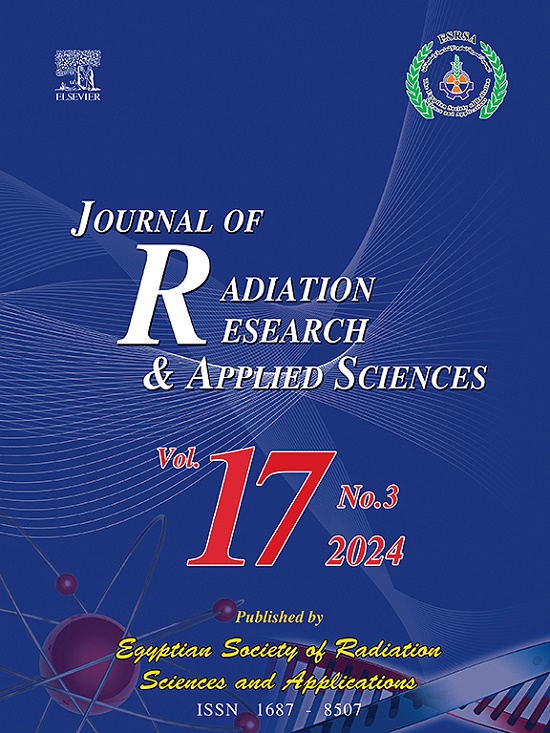剂量组学、放射组学、深部特征和临床数据的多模态数据集成,用于乳腺癌患者放射性肺损伤预测
IF 2.5
4区 综合性期刊
Q2 MULTIDISCIPLINARY SCIENCES
Journal of Radiation Research and Applied Sciences
Pub Date : 2025-03-03
DOI:10.1016/j.jrras.2025.101389
引用次数: 0
摘要
目的放射性肺损伤(RILD)是乳腺癌放疗患者的重要并发症。本研究提出了一个整合剂量组学、放射组学、基于深度学习的特征和临床数据的多模式预测框架,以增强≥2级RILD的早期发现和风险分层,最终支持个性化放疗计划。材料与方法对450例接受放疗的乳腺癌患者的数据集进行分析,包括高分辨率CT扫描、三维空间剂量分布以及年龄、BMI、肿瘤侧边、化疗方案、合并症等综合临床参数。通过体素重采样和强度归一化对成像数据进行标准化,并从放射组学(215个特征)和剂量组学中提取特征。基于互信息(MI)的特征选择用于增强模型性能,而带有注意机制的三维自编码器用于捕获与RILD相关的空间和结构模式。进行五重交叉验证以确保稳健性。结果类内相关系数(ICC)分析确定了最可重复的放射组学特征,在保持预测稳定性的同时显著减少了特征。多模态数据集成显著提高了分类性能,在使用基于mi的特征选择时,投票分类器的准确率达到95.89%,灵敏度达到96.98%。与独立的剂量学数据相比,深度特征显示出更好的预测能力。具有注意机制的3D自编码器模型进一步提高了预测精度,准确率达到95%,AUC为0.96,灵敏度为0.93。结论提出的多模式人工智能驱动方法可有效预测≥2级RILD,解决了传统剂量-体积指标的局限性。放射组学、剂量组学、深度学习和临床数据的整合提高了模型的准确性和可解释性,为个性化风险评估和优化放疗计划铺平了道路。未来的研究应侧重于外部验证和实时临床实施,以进一步完善预测能力。本文章由计算机程序翻译,如有差异,请以英文原文为准。
Multi-modal data integration of dosiomics, radiomics, deep features, and clinical data for radiation-induced lung damage prediction in breast cancer patients
Objective
Radiation-induced lung damage (RILD) is a critical complication in breast cancer patients undergoing radiotherapy. This study proposes a multi-modal predictive framework integrating dosiomics, radiomics, deep learning-based features, and clinical data to enhance early detection and risk stratification of Grade ≥2 RILD, ultimately supporting personalized radiotherapy planning.
Materials and methods
A dataset of 450 breast cancer patients receiving radiotherapy was analyzed, incorporating high-resolution CT scans, 3D spatial dose distributions, and comprehensive clinical parameters such as age, BMI, tumor laterality, chemotherapy regimens, and comorbidities. Imaging data were standardized through voxel resampling and intensity normalization, and features were extracted from both radiomics (215 features) and dosiomics. Mutual Information (MI)-based feature selection was applied to enhance model performance, while a 3D autoencoder with attention mechanisms was utilized to capture spatial and structural patterns linked to RILD. Five-fold cross-validation was performed to ensure robustness.
Results
The Intraclass Correlation Coefficient (ICC) analysis identified the most reproducible radiomics features, leading to significant feature reduction while maintaining predictive stability. Multi-modal data integration significantly improved classification performance, with the Voting Classifier achieving 95.89% accuracy and 96.98% sensitivity when using MI-based feature selection. Deep features demonstrated superior predictive power compared to standalone dosimetric data. The 3D autoencoder model with attention mechanisms further enhanced predictive accuracy, achieving 95% accuracy, 0.96 AUC, and 0.93 sensitivity.
Conclusion
The proposed multi-modal AI-driven approach effectively predicts Grade ≥2 RILD, addressing limitations of traditional dose-volume metrics. The integration of radiomics, dosiomics, deep learning, and clinical data enhances model accuracy and interpretability, paving the way for personalized risk assessment and optimized radiotherapy planning. Future research should focus on external validation and real-time clinical implementation to further refine predictive capabilities.
求助全文
通过发布文献求助,成功后即可免费获取论文全文。
去求助
来源期刊

Journal of Radiation Research and Applied Sciences
MULTIDISCIPLINARY SCIENCES-
自引率
5.90%
发文量
130
审稿时长
16 weeks
期刊介绍:
Journal of Radiation Research and Applied Sciences provides a high quality medium for the publication of substantial, original and scientific and technological papers on the development and applications of nuclear, radiation and isotopes in biology, medicine, drugs, biochemistry, microbiology, agriculture, entomology, food technology, chemistry, physics, solid states, engineering, environmental and applied sciences.
 求助内容:
求助内容: 应助结果提醒方式:
应助结果提醒方式:


